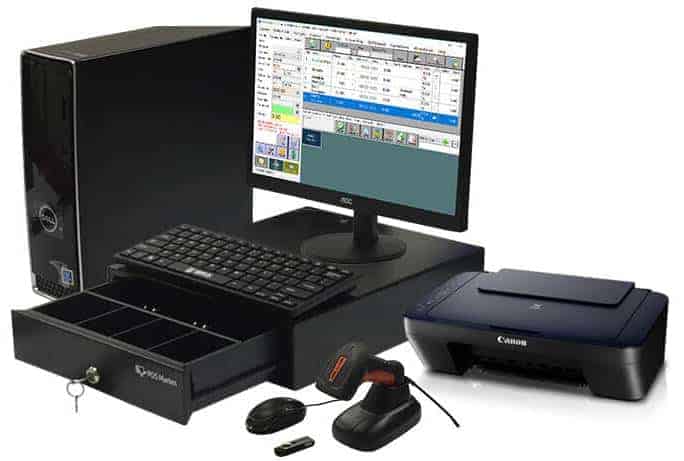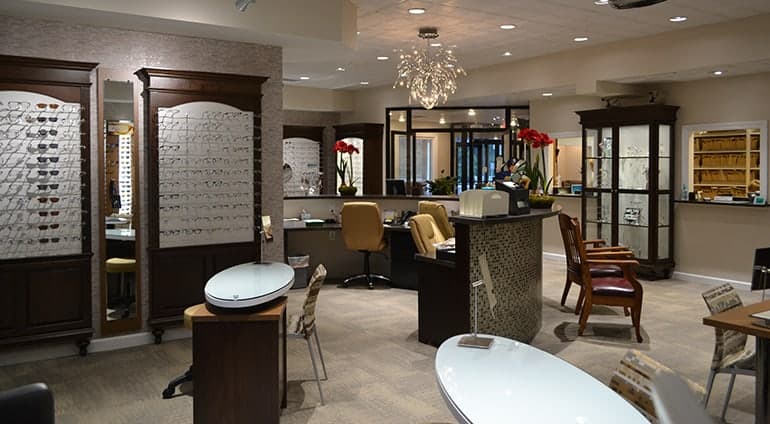
Managing all of that data requires a powerful point of sale system, that is tailored specifically for optical stores. Such a system provides inventory management, a large RX database, and direct posting to suppliers and vendors.
Based on our research, the best optical pos system is Vision Pro. It provides demographic-based patient management, a complex appointment management system, and Kiosk integration.
If you are ready to take your optical store to the next level, let’s check out the top optical POS software.
The Best Optical Store POS Systems
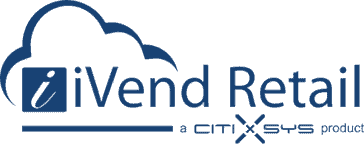 |
|||
 |
cost |
transaction |
|
 |
1. The Best Optical Shop POS System Overall: iVend

Best Optical Overall POS System
iVend Retail is the complete retail solution for managing in-store, online and mobile sales. It provides enterprise capabilities so you can focus on daily operations and deliver exceptional brand experiences to your customers.
Its omnichannel capabilities enable retailers to engage shoppers with personalized promotions across digital and physical sales channels. iVend Retail delivers integrated solutions for POS, Mobile POS, eCommerce, customer loyalty, digital passes and inventory management. Its certified ERP integrations help you optimise data use, gain visibility and scale quickly.
Retailers can easily run iVend on any Windows system android and iOS device with full access to core point of sale functionality. They can do everything from logging in, creating products to processing sales, receipts and refunds.
The software is very easy to setup and uses and is feature packed with the ability to do everything a retail store needs. The system also has a range of extensions that are available to suit specific retail requirements.
iVend has the ability to be integrated into the SAP Business One back office and provides a lot of information that can be used for reporting and analytics purposes. This allows for better decision making in the retail business.
iVend has a service portal that includes an e-learning library and knowledge base for all users. The service portal has single sign on access and provides a complete list of documents, tutorials, videos and a community forum. The documentation enables users to find what they need to get the job done quickly and efficiently.
Most of its current users particularly love the impressive multi-location and multi-user capabilities. Although the provider requires a relatively high upfront payment, the feature-rich software offers great value for money.
Some of the optical shop features and capabilities you will like about this system include:
Lens-Treatment Mapping Matrix
The system allows you to list the various treatments that may be administered on lenses based on their material, color and type. From the Master Data view, the system allows you to swipe across the screen to display different lens combinations for any particular treatment.
Tray Fulfillment and Management
The iVend optical shop POS system manages the various orders placed in your shop as a set of ‘trays’. In this regard, the software treats contact lenses and prescription glasses as individual trays, even when they are parts of the same order.
However, a single prescription glasses tray will include such items as the frame, clips, list of lens treatment options and qualified lenses for left and right eye. Once the order is ready, the system allows you to change its status to ready for fulfillment.
Seamless Patient Communication
As part of customer management, the iVend POS system makes it relatively easy for you to communicate with your patients. The software to manage appointments, engage your patients and optimize marketing efforts. All these are aimed at enhancing customer experience and simplify your workflow management.
The software offers multimodal, dynamic and intuitive tools, in this regard. With iVend, you can get in touch with your patients using two-way messaging, voice or email channels.
iVend POS System Downsides
The software is also known to be ‘buggy’ sometimes, especially after updates.
2. The Best Optometry Practice Management POS System: VisionPro POS

The system will also give you enhanced control over the entire business, with Rich patient data to influence decision making. Some of the features that make VisionPro one of the best optometry POS systems include:
Patient Management
To begin with, the software features an intuitive patient chart. From this chart, you can view such information as the patient’s allergies, demographic data, and balance information. Such information is displayed on the information bar at the top. The patient’s chart serves as the repository for all the patient’s information.
This feature is essentially designed to give you all patient data at a glance, including invoices, Rx, family and recalls, files and attachments as well as lab orders. The solution also features patient search capabilities, making it easy for you to retrieve patient data. In this regard, you my lookup for patients in the POS by address, name ID or phone number.
Appointment Scheduling
The software makes it relatively easy and convenient for you to book patient appointments. Similarly, the solution will allow you to incorporate non-patient appointments as well as walk-in patients into your schedule more effectively. You may as well print out your appointments for a certain optician or physician.
With this system, you will be able to filter your appointments by optician, physician, week, month or even date. This software will also make it convenient for you to reschedule or transfer appointments.
Rx Management
The RX tab on the VisionPro optical shop POS system contains information on patient prescriptions. From this tab, you will also be able to edit and print order prescriptions. The system displays the expired RX in a different color for easier identification.
The software allows you to create invoices from Rx prescriptions, as well as track lens information, physician, Rx date and expiry. Again, this feature offers unlimited prescription options for each one of your patients. Large optical shops integrate Kiosk POS as well.
3. The Best Optometry-Specific POS System: FlexOptical

The solution is also known to offer extensive inventory management as well as cloud/web hosting capabilities. Other capabilities optometrists have come to like about this POS system include:
Insurance Tools
The software is designed to collect and store relevant patient information on previous and current insurance coverage. Additionally, the software will also help you collect other important details like ID and group numbers. Such details will give you the basics you need to apply fees throughout the patient’s ordering process.
Dispensing Status
According to its current users, the FlexOptical optical shop POS system offers you a convenient way to manage the status of each and every order. In this case, the software lets you monitor the progress on each pending order from a single screen. For enhanced visibility, the system summarizes and color-codes the contact lens and spectacle orders in your shop.
Color-coding by this solution is based on the status of each order. This gives you a complete overview of the ordering process and makes order management relatively easier.
Vision Web Integration
Integrating an ecommerce platform into your POS system will create an additional revenue stream for the business. To make this possible in your optical shop, FlexOptical offers you the innovative Vision Web Integration capability.
Though simple to use, this platform features a rather powerful interface. The platform is essentially designed to serve as the online storefront in your shop. As such, your patients will have an easy time placing contact lens or spectacle orders online.
Things You Need to Know Before Choosing an Optical Shop POS System
The EMR solution you get should give you a complete overview of your patients’ health histories. Additionally, the system should have the right set of tools for enhanced patient care. You will also need a solution that makes it relatively easy for you to manage and follow up with the patients.
This being the case, it is advisable to settle for a POS solution that is specifically designed for a retail optical shop or Optometry Practices. In addition to the technical functionality, the system should give you visibility into store performance, as well as schedule and manage appointments.
Discussed below are other aspects you should consider while shopping for the best optometry POS system:
Patient Information Management
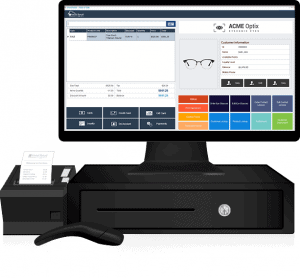
The system should also be capable of tracking patients’ Intraocular Pressure (IOP). Monitoring the IOP levels will help you ascertain their likely hood of contracting such conditions as glaucoma.
Ability to store patient information
The ability to adequately store and access patient data can help you improve the way you deliver care and provide services. By streamlining the way data is stored, you can better utilize information and increase the accuracy of medical records. This also enables you to respond more quickly to regulatory changes.
You should keep in mind that your patients have the right to request copies of their health records. However, you must be careful when transferring this data to ensure it stays confidential. Keeping up with HIPAA regulations is crucial for protecting your patient’s privacy.
Whether you are storing paper or electronic medical records, it is important to follow proper guidelines for storage and security. The duration for which you must store clinical records varies by state and additional federal guidelines apply. Additionally, you should not disclose medical records to anyone outside of your practice unless you have explicit authorization from the patient.
One of the biggest reasons for HIPAA violations is mishandling of data by staff members. It can be as simple as writing an incorrect address or phone number on a form or accidentally saying protected information out loud. This is why regular training on HIPAA regulations and processes is essential.
It is a good idea to use acid-free sleeves and folders to store your paper medical records long-term. Regular paper has acid, which can leach into the records and damage them over time. It is also a good idea to keep your electronic medical records in a secure location, such as a fireproof cabinet or offsite location.
Workflow Management
The right optometry POS system should also feature important workflow management capabilities. Managing appointments, eye exams and visual field exams for the various patients using a pen and paper can be daunting. In addition to automating such tasks, the right solution should manage diagnosis and treatment recommendation data for your patients.
Again, you will need software that makes it easy and convenient for you to schedule follow-up visits. A system that is capable of sending out appointment reminders automatically will also come in handy.
Inventory Management

Additionally, the system should have multi-dimensional capabilities to monitor the various items attributes, such as gender, color, shape, lens material, and power. The system should also automate stock management to reduce redundancy and ensure uniformity.
Integrations Support
Most of the leading optical shop POS systems support integrations with the best third-party optometry services. For instance, you should consider getting a solution that can integrate with eye/vision exam devices.
With such an integration, you can easily populate your workflow templates with your keratometer and autorefractor data. Such data will come in handy whenever you need to offer your patients additional support diagnosis.
Customer Relationship Management

For the best results, your preferred optical shop POS solution should be capable of greeting, engaging, informing and rewarding your customers. The system should also make it easy for you to follow up with your patients, preferably through email and SMS.
Such a capability will keep the patients updated on new stock arrivals, order ready intimation, replenishment date reminders for contact lenses, and appointment reminders. The solution should also allow you to personalize greetings as well as seasonal and festive marketing campaigns.
Optometry Templates
Some of the best optometry-specific POS systems feature note templates that are specifically meant for this practice. In this regard, you should look for such templates as lost/blurred vision, eye exam, glaucoma, conjunctivitis, diabetic retinopathy, and macular degeneration.
Invoicing, Dispensing, and Insurance
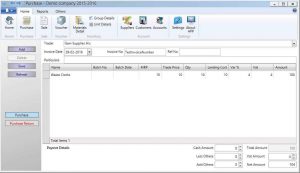
With regards to dispensing, your preferred system should have auto-fill functionality. Additionally, the system needs to automate such processes as accounts, debit and reward points management. It is also advisable to go for a system that supports invoicing in multiple currencies.
The best POS system for optical shops should have insurance management capabilities as well. Such tools, in addition to invoicing, will make it easy for you to fill and keep track of claims. Additionally, the system should automate the generation of relevant claim-related reports and forms.
Our Final Verdict
The best POS solution for an optical shop should be capable of collecting and managing important data and health history. Again, the system should feature industry-specific point-of-sale capabilities for fast, accurate, and profitable transactions.
Like the three systems reviewed in this guide, your preferred solution should have essential tools for patients scheduling, order processing, sales management, and reporting. Additionally, you will need a system that is relatively easy to learn and use.
Whether you need optical retail software or an optometry practice solution, this guide will help you choose the best optical shop POS system.

